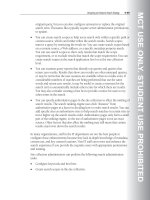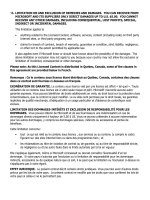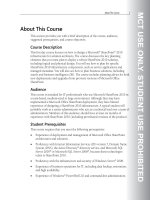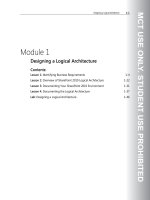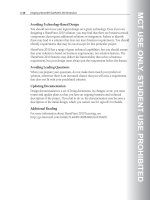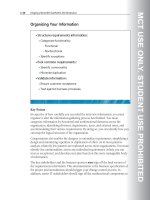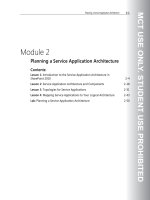Designing a Microsoft SharePoint 2010 Infrastructure Vol 1 part 18 doc
Bạn đang xem bản rút gọn của tài liệu. Xem và tải ngay bản đầy đủ của tài liệu tại đây (1.16 MB, 10 trang )
MCT USE ONLY. STUDENT USE PROHIBITED
Planning for Performance and Capacity 3-37
Performance Testing in SharePoint 2010
Key Points
You can use several tools to help you to perform performance testing against your
SharePoint servers. One of the most comprehensive load-testing tools for
SharePoint environments is Microsoft Visual Studio® 2010.
The following table describes load-testing configuration options for Visual Studio
2010.
Configuration Description
Local load generation In this configuration, the client computer running Visual
Studio generates all of the Web requests for the load test.
The load test is limited to 250 virtual users, and the test
only uses one core of the client CPU.
Distributed test controller
and test agents, optionally
stacked with client
computer.
In this configuration, you distribute the test controller and
test agents across different computers to scale out the
load agents and increase the test load. You must install
virtual user packs on the test controller computer to
enable testing. This configuration enables the use of all
MCT USE ONLY. STUDENT USE PROHIBITED
3-38 Designing a Microsoft® SharePoint® 2010 Infrastructure
Configuration Description
CPU cores on the load agent computers. This
configuration is suitable where a team will be performing
testing.
Optionally, you can use the client computer running Visual
Studio as the test controller computer. This configuration
enables all cores and more than 250 virtual users on the
client computer, but is only recommended for scenarios
where an individual will perform testing.
After you have chosen your configuration for Visual Studio, you should create a
new project in Visual Studio. The project requires configuration of two elements:
• Web tests. Web tests are an instruction for the Visual Studio load test engine to
retrieve a specific Web page or URL.
• Load tests. Load tests are a collection of tests to perform as a batch. Load tests
typically include a number of Web tests and enable you to configure ratios
between the individual Web tests included in the load test.
Note: Visual Studio load-test projects can include a “think time” variable, which is
intended to mirror the behavior of users browsing a Web site, such as pausing between
pages. For the test to return a “raw” RPS value, it is recommended that you ignore this
feature.
In addition, you can configure Visual Studio to capture performance counters from
the servers that you are testing during the test. You must add any counters that you
want to capture to the load-test project.
You can also specify the duration for the load test. You should run the load test
over a period that will ensure that all operational factors are included, such as
timer jobs or index crawls.
Note: You can use the Load Testing Toolkit (LTK) to test whether an existing Office
SharePoint 2007 topology can sustain an upgrade to SharePoint Server 2010 with the
same load. The LTK is available as part of the SharePoint 2010 Administration Toolkit.
MCT USE ONLY. STUDENT USE PROHIBITED
Planning for Performance and Capacity 3-39
Caching in SharePoint 2010
Key Points
SharePoint 2010 has several methods of caching data and objects to help improve
performance for the end user.
When a client requests a page, a copy of the page is stored temporarily in the
output cache. Although the duration of the cache is typically small (the default is
60 seconds), this can greatly assist the performance of WFE servers and reduce
latency.
Cache profiles are available so that site administrators can control the output cache
behavior. Administrators can also determine whether different users, such as
content editors, receive cached pages. You can adjust the output cache at the site,
site collection, or Web application level.
SharePoint 2010 uses the object cache to temporarily store objects such as lists,
libraries, or page layouts on the WFE server. This enables the WFE server to render
pages more quickly, reducing the amount of data that is required from the SQL
Server databases. You can adjust the size of the object cache at the site collection
and Web application levels.
MCT USE ONLY. STUDENT USE PROHIBITED
3-40 Designing a Microsoft® SharePoint® 2010 Infrastructure
The page output and object caches are memory-based and will require testing to
determine the optimum setting for a site or site collection.
Note: The page output cache and the object cache only take effect on sites that have the
Publishing feature enabled.
SharePoint 2010 has a BLOB cache that temporarily stores digital assets, such as
image or media files, but you can use it with any file type. Using the BLOB cache in
conjunction with the Bit Rate Throttling feature in IIS 7.0 also enables the
progressive download feature for digital assets. Progressive download enables the
download of media files in chunks of data, and playback can start after the client
downloads the first chunk rather than the whole file. You can enable and control
the size of the BLOB cache at the Web application level. The default size is 10 GB
and the default setting is disabled.
For deployments where you want to make use of digital assets, you should enable
the BLOB cache for the relevant Web applications. You should perform the change
on all of the Web servers that host the specific Web application. If there are large
quantities of digital assets or they are heavily used, consider increasing the size of
the BLOB cache. Alternatively, you can dedicate a specific Web application to
media files, such as digital assets, and configure a much larger BLOB cache for that
Web application.
Note: The page out cache and the object cache are memory-based caches on the WFE
servers. The BLOB cache is a disk-based cache on the WFE servers.
Question: Where do you configure the settings for the BLOB cache?
Additional Reading
For more information about cache settings operations in SharePoint Server 2010,
see
For more information about planning for caching in SharePoint Server 2010, see
MCT USE ONLY. STUDENT USE PROHIBITED
Planning for Performance and Capacity 3-41
Lesson 3
Principles of Capacity Planning
Your initial planning for a SharePoint Server 2010 deployment must include
sufficient storage capacity to accommodate the content that users will store in
SharePoint storage repositories, and the additional needs of the SharePoint farm,
including administrative and service application requirements.
Objectives
After completing this lesson, you will be able to:
• Identify capacity requirements.
• Identify architecture and storage elements in SharePoint 2010 that affect
capacity planning.
• Identify supporting environmental factors that affect capacity planning in
SharePoint 2010.
• Identify storage and database options for a SharePoint farm.
• Identify content considerations that affect capacity planning.
MCT USE ONLY. STUDENT USE PROHIBITED
3-42 Designing a Microsoft® SharePoint® 2010 Infrastructure
Capacity in a Business Context
Key Points
When IT professionals discuss capacity, storage is typically at the forefront of that
discussion. However, it is important that you consider other aspects of capacity,
such as network capacity or performance capacity.
SharePoint 2010 stores most content in SQL Server databases; therefore, capacity
planning for storage involves a large amount of database planning. It is important
that you understand content characteristics to plan for the corpus (the total
amount of data to store in SharePoint 2010). You should also understand how
logical architecture fits together with database storage. This will enable you to plan
for the right number of databases, split content among databases correctly, and
plan for database growth.
You must also consider network capacity, particularly in terms of client access
connections to WFE servers—and application servers in some cases. New features
in SharePoint 2010 such as Office Web Apps and digital asset storage and playback
introduce additional network traffic requirements over previous versions of Office
SharePoint.
MCT USE ONLY. STUDENT USE PROHIBITED
Planning for Performance and Capacity 3-43
Finally, consider the business requirements for the solution. What are the
performance requirements? Will the solution have performance headroom to
enable growth in users with the same performance requirements?
MCT USE ONLY. STUDENT USE PROHIBITED
3-44 Designing a Microsoft® SharePoint® 2010 Infrastructure
Principles of Capacity Planning for SharePoint 2010
Key Points
When you size capacity requirements for storage, it is important to identify how
different storage requirements and different data types will affect database and site
collection design.
SharePoint 2010 has certain boundaries and limits that affect storage choices,
which include:
• An individual SharePoint content database should not grow beyond the
supported limit of 200 GB.
• An individual file that you store in SharePoint 2010 cannot be larger than the
boundary limit of 2 GB.
• A single list row cannot exceed the boundary limit of 8,000 bytes per row.
If you have large quantities of data (greater than 100 GB) to store in SharePoint
content databases, you must consider how to arrange that data in multiple site
collections. This is because site collections cannot span separate content databases.
MCT USE ONLY. STUDENT USE PROHIBITED
Planning for Performance and Capacity 3-45
If you want to make quantities of files available to SharePoint 2010 users, you can
store some content—for example, archive or static files—in other content sources,
such as a network file share. You can make this content available to users through
search or links in SharePoint 2010.
If you plan to store and manage digital assets, you may require extra storage.
Digital assets such as media files are traditionally much larger than documents.
Consider that metadata also requires storage in the content database and adds to
the size of the search database.
You must also plan your search capacity requirements, because there are additional
limits that are associated with search indexes. These limits include the number of
crawl databases and the maximum index item limit.
Additional Reading
For more information about the software boundaries and limits of SharePoint
2010, see
For more information about storage and SQL Server space and I/O requirements,
MCT USE ONLY. STUDENT USE PROHIBITED
3-46 Designing a Microsoft® SharePoint® 2010 Infrastructure
Principles of Capacity Planning for Supporting Elements
Key Points
In addition to planning capacity requirements for the elements of the solution that
are specific to SharePoint 2010, you must also plan the capacity of supporting
elements in the network environment.
You should place domain controllers on the same high-speed network segment as
the SharePoint farm, to support logon requests at the SharePoint farm or to
support a connection for importing user profile data from the Active Directory®
directory service.
If users will be connecting over wide area network (WAN) or Internet links, you
should consider the quantity of data that clients transmit and receive over the link
and the number of concurrent users on the link.
SharePoint 2010 introduces new features that affect network traffic. The following
table lists the new features, with an overview of the traffic and payload quantities.
